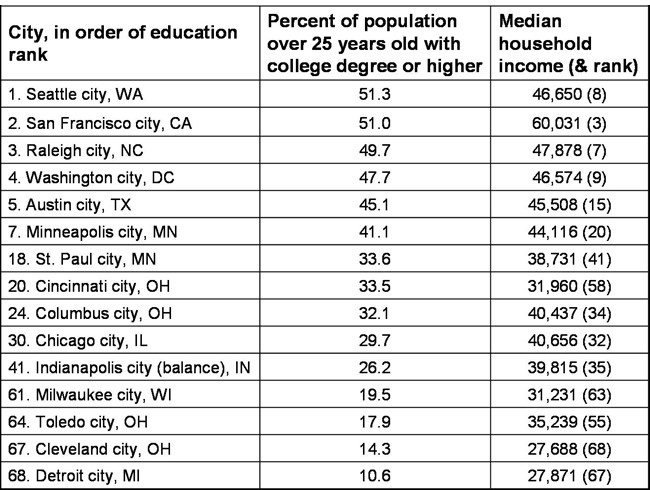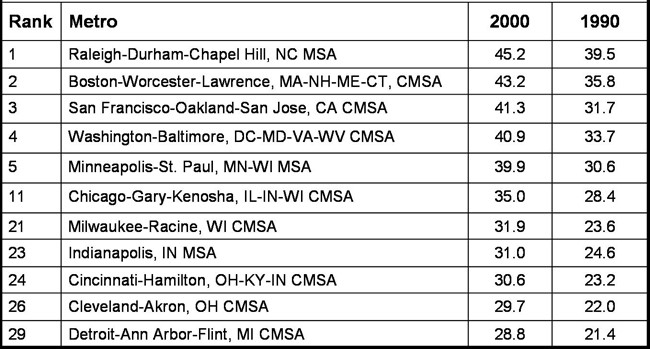Economic Development Strategy
What is regional economic development? Economic development is a set of strategies (EDS) that try to improve the well-being of people who live in an identified place. Conceptually, the place may be a region of the world, a nation, a sub-national region, a state, metropolitan area, city, or neighborhood. In the United States, EDS are most often applied to geographic areas that are smaller than the national level, especially from communities on up to states or multi-state regions.
We can think of several very general EDS along the following dimensions:
- Enhancing economic opportunities for people in a specific geographic area through heightened labor demand (e.g., usually through jobs development or the attraction of firms and capital); i.e. “bringing jobs to people.”
The marketing and promotion of regions are common EDS, along with more fundamental fashioning of a region’s business climate to attract investment and firm start-ups. An understanding of decisions about firm location and investment location is important for those regions that attempt to hike local labor demand by lowering firm costs of doing business through favorable tax or fiscal incentives. A useful introductory collection of essays on firm location decisions and economic policy can be found in Henry W. Herzog, Jr., and Alan M. Schlottmann, 1991, "Industrial Location and Public Policy", Knoxville, TN: University of Tennessee Press.
- Enhancing economic opportunities for people in a specific geographic area through heightened labor demand (e.g., usually through jobs development or the attraction of firms and capital); i.e. “bringing jobs to people.”
- Improving workforce skills and education, thereby creating opportunities for people to qualify for existing jobs.
The literature here is vast and varied. For a broad policy perspective, see the essays on returns to education by Nobel Laureate James J. Heckman. Among his recommended policy interventions are to “catch ‘em while they’re young” (invest in early childhood education), though his writings are nearly comprehensive concerning other possible actions such as adult workforce training and the efficacy of school reforms (e.g., voucher programs).
- Improving workforce skills and education, thereby creating opportunities for people to qualify for existing jobs.
- Accomplishing both of the above for an economically depressed area.
Perhaps to meet the most common demand for an economic development strategy a region would need to employ a dual approach. That is, to raise local work force skills at the same time that local job opportunities are created for those skills. Obviously, this is a tall order, especially in that these two achievements most likely must take place in the same time period.
- Accomplishing both of the above for an economically depressed area.
- Linking more closely existing jobs or labor demand to available workers through several means.
These would include providing easier transportation (more convenient commuting), greater affordable housing closer to job sites, and improved labor market information or lower transaction costs for filling or matching existing jobs. The so-called jobs mismatch hypothesis suggests that housing segregation or residental building patterns isolate low-income workers from job opportunities.
For an introduction to academic studies of jobs mismatch, see Katharine L. Bradbury, Yolanda K. Kodrzycki, and Christopher J. Mayer, 1996, “Spatial and labor market contributions to earnings inequality: an overview – Special Issue: Earnings Inequality,” New England Economic Review, May-June.
- Linking more closely existing jobs or labor demand to available workers through several means.
- Having people migrate to outside regions of greater opportunity.
Such a strategy is seldom advanced by politicians and policymakers. Local residents, even in depressed areas, rarely want to leave their home regions, and local politicians do not often find it in their interests to encourage “their votes” to migrate. Yet, migration is an important mechanism to improve well-being on the world stage, and in highly mobile places such as the U.S.
- Having people migrate to outside regions of greater opportunity.
The theories and ideas behind existing EDS typically derive from economic theorists and their academic studies of the mechanisms described above. However, historically, economics discipline/theory has generally developed as a nonspatial discipline. It was not until the latter half of the 20th century that theorists widely began to include space in economic models and thinking.
Theory and empiricism on urban and regional behavior, especially with U.S. applications, can be found in several American journals, the most prominent of which are:
For “more applied” and practitioner’s journals of U.S. EDS and applications see:
Several general books on EDS and associated case studies are helpful and accessible to those with basic economics training would find them readily accessible:
- Timothy Bartik, 1999, “The market failure approach to regional economic development policy,” in Approaches to Economic Development: Readings from Economic Development Quarterly, Thousand Oaks, CA: Sage Publications.
- Timothy Bartik, 1991, Who Benefits from State and Local Economic Development Policies?, Kalamazoo, MI: W.E. Upjohn Institute.
- Peter K. Eisinger, 1988, The Rise of the Entrepreneurial State, Madison, WI: University of Wisconsin Press.
- Popular discussion and application of EDS centers on several areas. Economic clustering is perhaps most discussed. Clusters often denote a highly concentrated group of firms in the same industry or a group of firms or business activities that closely interact through trade or the sharing of technology, infrastructure, or work force. When and where such clustering gives rise to competitive advantage, high productivity, and rapid growth, it is of great interest to those regions who hope to nurture their own clusters or to build new ones in their region.
Economist Alfred Marshall, for one, first discussed the importance of proximity in fostering “centers” or “clusters” of industry and economic growth. Urban and regional economists have been writing/modeling these phenomena and the interactions between geography, scale, and trade, for 40 years or so. Economist Paul Krugman belatedly discovered the urban-regional literature for the mainstream economic profession and set it down in mainstream economic journals, such as the Journal of Political Economy and the American Economic Review, as well as a book, especially within the context of international trade.
In the context of regional development strategy, these ideas have been recently popularized by Michael Porter of the Institute for Strategy and Competitiveness and are being applied in the EDS of many states and regions. Porter’s website contains the theory and information on cluster strategies and also includes descriptions of applications from the U.S. and across the world.
The theory of cluster formation and strength is especially popular in strategies to create and promote centers of technology activity and technology transfer, following Silicon Valley’s success. For examples, see:
- Andrew Reamer, 2003, Technology Transfer and Commercialization: Their Role in Economic Development, Washington, DC: U.S. Department of Commerce, Economic Development Administration.
- Richard K. Lester, 2005, Universities, Innovation and the Competitiveness of Local Economies, MIT, Local Innovation Systems Project.
- Jerry Carlino, 2001, “Knowledge Spillovers: Cities’ Role in the New Economy,” Federal Reserve Bank of Philadelphia, Business Review, Fourth Quarter.
Owing to the success of some prominent high-growth technology centers such as the San Francisco Bay area, many regions have also sought to foster entrepreneurial activity among local workers and business people in hopes that high-growth new businesses or industries may be created.
Ideas about globalization trends have also permeated EDS. It seems that everyone is now reading and citing Thomas L. Friedman’s The World is Flat: A Brief History of the Twenty-first Century. In it, Friedman’s thesis that heightened globalization has eliminated many local economic advantages for communities in the developed world, as well as made most goods and services “tradable,” is taken to its extreme. While globalization has indeed exposed many regions to heightened competition, the world is far from flat. It is still quite mountainous or “spiky”; it is full of clusters where location matters. Far from existing in obscure and competitive flatness, specific places maintain their prosperity and competitive edge through cluster relationships where infrastructure, technology, specialty activities, entrepreneurial culture, human capital, and quality of life are quite significant.
Economist Edward L. Glaeser believes the world to be spiky and has explored the relative prosperity and sources of growth of large cities in the U.S. economy. Large cities tend to be clusters of highly educated workers and occupations, and the income or wage premiums for highly educated workers has been surging in recent decades. One recent paper by Glaeser finds that the share of the adult population with college degrees increased more in cities with higher initial schooling levels. This divergence may be driven by the tendency of skilled entrepreneurs to innovate in ways that employ other skilled people.
Below is the ranking of the largest U.S. cities by share of work force having college degrees. A few Midwest cities, such as Minneapolis, Cincinnati, and St. Paul, sneak in near the top. Some other Midwest cities are listed for reference.
1. Education and income rank by place, 2004

City leaders themselves have surely noticed the tendency of such cities to grow rapidly, and accordingly, they have been active in trying to boost their attractiveness to educated workers. Since young workers are more mobile, efforts have been chiefly directed toward them.
One who especially believes that places should aspire to a high quality of life and robust entrepreneurial culture is Richard Florida. His book is especially popular in discussions of urban development. Florida’s thesis is that returns to human capital and entrepreneurial activity reign supreme; physical capital is secondary. Cities should encourage in-migration of creative types including artists, gays, techies, and business-builders. High quality of life, urban amenities, and social diversity are economy-builders.
The table below is drawn from Joe J. Cortright, who has also been researching the correlations between an educated work force and economic growth. Shown here are the share of young adults having a four-year degree or higher, not for cities, but for entire metropolitan areas. In the Midwest, the Chicago and Twin Cities metropolitan areas are the regional magnets for the young and educated.
2. Share of 25 to 34 year-old population with a 4 year degree or higher in the 50 largest metro areas, 2000

The range of possible EDS is very large. Regions themselves vary along many dimensions so that, in fashioning EDS, local investment, institutions, and programs are (ideally) chosen to complement a region’s own characteristics and position. However, even with well-crafted EDS, success is far from certain. Regional economies are often buffetted by events and forces that are impervious to local EDS. In such an uncertain world, investing in general education and health at an early age seems to be all the more attractive. For one, these assets are portable if out-migration becomes necessary or desirable.








